|
Toby
O’Brien: Eternal Life (The Miracles of Love)
Martin Holman
Love is the hastening
gravitation of spirit towards spirit, and body towards body, in the joy
of creation... And therefore, for those who are in love with love, to
travel is better than to arrive. For in arriving one passes beyond love,
or, rather, one encompasses love in a new transcendence.
D.H. Lawrence in Phoenix: The Posthumous Papers of
D.H. Lawrence, New York, 1968, p. 151.
Lawrence’s poignant observation finds an echo in the paintings,
sketchbooks and writings of Toby O’Brien. I doubt, however, that O’Brien
has encountered the quote and he may never thought of Lawrence as a
fellow traveller. Yet the two artists appear to circle profound emotion
in comparable orbits. Like Lawrence, O’Brien’s journey is far from
complete. And that is a good sign.
For both men, love and religion are linked. For neither, however, is
connection found in conventional or institutional ways. ‘Sacred love is
always in our hearts, forever’ writes O’Brien in one of his sketchbooks,
the pages of which bristle with spiralling lines, jarred statements and
questions about the existence of fidelity and faith. ‘Religion does not
exist,’ he declares; and then he asks ‘Does anything exist?’ Lawrence,
raised in the Congregationalist tradition, also doubted the institutions
of belief of his time. He discarded Victorian structures of belief,
telling his minister as a young man that ‘I cannot be a materialist but
a Cosmic God I can … believe in.’ O’Brien may well agree. His recent
paintings point that way and, maybe unknowingly, subscribe to the
Lawrence’s credo: ‘Our religion is loving’.
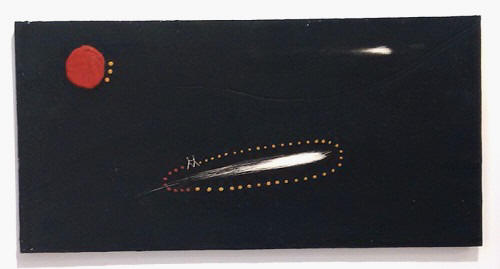
Equalising the World’s Faith, 2020, oil paint on gesso
panel
At least, that speculation
provides a lens through which to see this show. A painting called
Equalising the World’s Faith lays a very black field of paint across
the smooth surface of a rectangle of wood. Consequently, the perimeter
borders an interior space which seems ineluctably flat and, in the
density of blackness, immensely far-reaching at the same time. Three
dominant shapes occupy the ground and around two of them gather smaller
dots. On the top left is a juicy circle of terracotta red, as physical
as a coin of gum trodden into the pavement, that has attracted three
lividly yellow spots. At top right is its material opposite, a feathery
mark in white with a tapering tail that resembles the icy trajectory of
meteorite alight in the night sky. That shape has no satellites, perhaps
on account of its speed and perceived evanescence.
Below both and roughly in the centre is a third shape: another streak of
white and this time larger. Its shape also implies the velocity of its
passing, except that this form is ringed by spherical marks, mostly
yellow again but with some warming into red. The viewer confronts the
contradictions of, first, what is moving and which is merely hovering,
and then whether the comet at the centre has been halted in its progress
to the distant edge. Its cordon of acolytes appear like an escort of
spherical outriders in the manner of a visiting dignitary. The equivocal
title that O’Brien accorded the mysterious arrangements of marks will
puzzle the onlooker. Nonetheless, that person is already too deeply
invested in meaning n to pull away unsatisfied by a kind of universe in
which celestial concepts are perceived. The pulsing energy contained
into rectangle has a thread running, offering a connection upon which a
pinhead couple walk together in apparent amity.
Artists usually turn to abstraction because they harbour a desire to
change the world. By only alluding to natural phenomena, abstract work
avoids being parochial and implies universality. O’Brien, who lives in
Penwith and is self-taught in art, fell into abstraction as the quickest
way to start what he felt strongly needed to be done. That was to create
in order to search and thereby to change. That urgency is palpable is in
his paintings and it spirals off the pages in the driving lines of his
drawings. While he may not be a born painter, he is naturally a maker of
marks and, in his grand design, those marks have to add up to subject
matter on a level beyond the world that surrounds him.
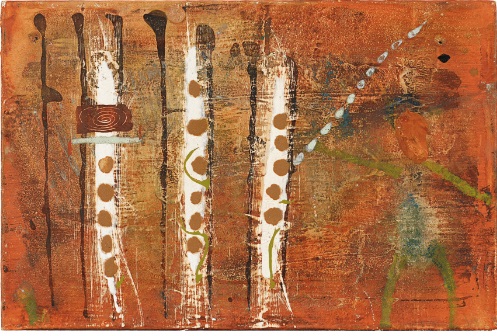
These Pirates’ Eyes, 2019, oil and ink on gesso panel,
200 x 300 mm
The nearest he approaches
figuration is through primal, humanoid shapes. The simplest appear as
the emblematic couple in Equalising the World’s Faith. In
These Pirates' Eyes he experiments with more developed types: one,
on the right, is drawn with single green strokes for limbs and head,
converging on a feathered mass that might be a clothed body. The other
is found in the screen of inflected verticals to left. In fact, it is
hard to decide which is the figure type and which an implement that
figure is holding, because between the slimmest forms are broader white
ones, that fizzing sparkler-like shape again, and this time alive at top
and bottom. The shafts of those verticals are dotted in brown and could
be rudimentary tunics. Indeed, the whole conception is rudimentary, as
if the encounter existed in an early stage of evolution, when species
began distinguishing themselves from mitochondria, but conveniently
conflated in their conception here with the moment when tools first came
to hand.
Strictly speaking, millions of years separated those events. But time is
not a factor in O’Brien’s paintings. If it is, he thinks in cosmic time
of aeons and light years, with black holes thrown in as great swallowers
of data. Because O’Brien also knows that abstraction permits the maker
to span vast arenas of possibility in search of change. Like those
feelings, his technique is intuitive and not tied to a prevailing style.
Whereas he has collected inspiration from a raft of historical figures,
from Turner’s most romantic landscapes to the informality of post-war
abstract expressionism, especially the European variety termed art
informel associated with Antoni Tàpies, also essentially self-taught as
a painter (the few art classes he attended left little impression on
him), and the rough calligraphy of the American ex-patriot imbued with
classical Italy, Cy Twombly. He may have responded to them because
inherent in their practice is an almost tactile acknowledgement of the
past and of today’s experiences being built upon those of previous
generations. Above all, they concentrated upon the transformation of
their materials through handling. O’Brien, however, has mostly found his
own way towards self-expression and sought encouragement, adjustment and
corroboration in the work of others.
Another influence is writing. The stuttering, repetitive nature of
written lines in sketchbooks declare for him the insufficiency of
language to delve sufficiently deeply into the enquiry that preoccupies
him. So the sketchbooks follow his tentative movement away from the use
of words towards marks with the quality of notation. Onto these he loads
a cargo of meaning; they communicate some essential idea about what it
is to be human – to be individually human. And in the manner of emergent
languages, meaning sometimes fails to come across although the effort
carries its own narrative. The third influence is memory and includes
the recollection of work already made, of mixes explored and gestures to
build on.
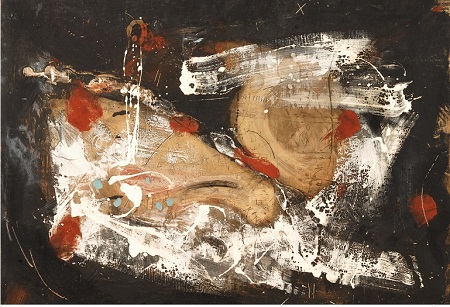
Beyond Reason/Atoms of Reason (Stratospheric Sounds),
2020, mixed media on gesso panel, 690 x 970 mm
To arrive at the image that
constitutes Beyond Reason/Atoms of Reason (Stratospheric Sounds),
O’Brien prepared the MDF panel with layers of gesso, a white paint
mixture consisting of a binder medium mixed with chalk that has been a
constituent of painting for centuries. Several layers of this mix are
needed and as each dries, it is sanded smooth. The surface built up in
this manner is hard but, depending on the degree of polishing, can have
the luminescence of paper as well as an illusion of alabaster-like
density. The process requires patience and manual labour, as does
O’Brien’s habit of adding a layer of dark paint over the gesso. Both
light and dark trigger his imagination, and he might try to move back
from the dark again by rubbing the surface to release its inner,
obscured light. Or go further to retrieve the grain and tone of the wood
itself. But the ghost of what had been above stays in the wood; it
cannot be entirely eliminated. These elements provide the painter with
properties (colour, texture, scale and edge) to work with and against as
his hand passes over the surface, first to prime, then to sand and then
to paint, and edit while painting by taking away.
This motion feeds energy which nourishes feeling, and the outcome can be
convulsion of unsettled marks made by a variety of implements – a slim
brush or stick to drip from, perhaps, a cloth to wipe with; a broad,
soft brush with pigment in its bristles; and a sharp point to score
random lines into the wood. The painting is as inarticulate as if it
precedes language; indeed, the swell of gestures around two adjacent
ovals aims to obliterate form with friction – as if abrasion might
create new forms that can be believed in. Yet, as before, the opposite
might also be true: what occurs in the breaking of wave-like surf in the
vortex at the picture’s centre is the resolution of the act of creation
itself, imagined at the physical level or with a cosmic dimension, with
both too extraordinary to grasp. The uneven cells in red and blue that
appear to lift off the commotion and advance beyond the surface have
mystic potential to change themselves.
This primal quality appears both the product of novelty and
intelligence. The novelty derives from the artist’s relative newness to
painting; his technique is in formation. As he embarks upon the journey
of testing his aspirations against his growing ability to transform the
dead materials available to him into the living expression of his take
on the world, his imagery reflects that state of coming into being
rather an emphatic statement of ‘I am here’. The intelligence is visible
in his awareness of being a newcomer and the licence that gives him to
take risks. By working the surface with rubbing or sanding the
preliminary layers of smoothed white and a coarser black, O’Brien
agitates the surface and his mind into environments that his marks can
occupy. His actions connect each panel with his inner state of mind and
the result can be strangely beautiful.
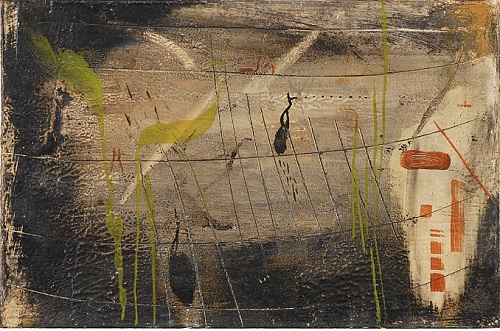
Death of Massachusetts, 2019, oil and ink on gesso
panel, 200 x 300 mm
The impression of opening the
flat surface into interior space enlivens the beguiling composition of
Death of Massachusetts. That supposed space might be air or
water. Objects ‘float’ there that have weight (the black, tadpole-like
shapes) or seem light enough to be subject to any river current (the
green drips and ‘fronds’). The space itself is indeterminate in terms of
depth and purpose because accident probably brought it about. This
product of technique, of rubbing away light and dark layers, alludes to
an atmosphere that generates an image: darkness is either evaporating or
is closing in from the edges. The painting has overtones of pre-war
English romantic art; a certain moment of John Piper’s career comes into
mental view when, after turning away from geometric abstraction, the
artist adopted a naturalistic figuration that emphasised emotion and
introspective individualism while glorying in the past and in nature.
In that phase of his life, Piper often painted buildings – Gothic
churches mostly perceived in organic colours heightened by strong
primary tones of stained glass. The cumulative effect was of permanence
(with imagines a future) but also decay, even desolation (which assumes
finality), and O’Brien conjures a similar impression. Piper was an
inveterate traveller, too, and his journeys were metaphorical as well as
topographical; architecture gave his memories structure. O’Brien varies
his structure between fluid compositions, such as Beyond Reason/Atoms of
Reason (Stratospheric Sounds), that stress the dynamic urgency of direct
feeling transmitted in materials, and a basic architecture of his own
devising which slows the speed of the image and, conceivably, of its
making, too.
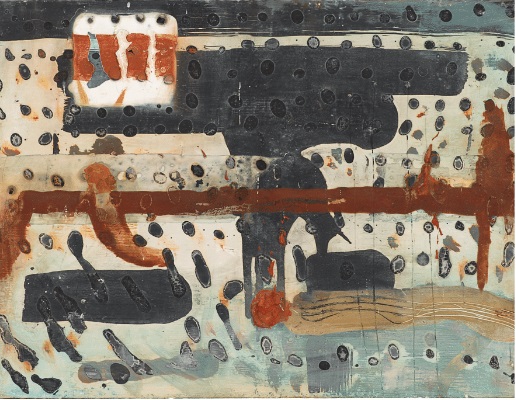
Forgotten Hymns, 2020, oil and ink on gesso panel, 200
x 400 mm
One example is Forgotten
Hymns. Here broad gesture gives way to a gentle formality, even to
self-consciousness that has tempered the rawness experienced elsewhere
with an element of predetermination. The tonality of this painting is
lighter than most of its peers, with broad band of white ground to
separate margins of black inflected with lighter blues to variegate the
surface. Within the light area are dark horizontal shapes with rounded
edges in that same inky bluish-black, unrecognisable as objects and so
accepted as shapes alone. From one side to another runs a bar in
terracotta red like a waistband that is going towards oxblood in colour.
Or is its function equatorial, between the darker north and the brighter
south that has room for a swatch of sandy ochre? In there, as well, is a
wash of the medium sky-blue that O’Brien likes to use as counterpoint to
reds and blacks.
But prominently distributed all over the picture plane are rows of
unevenly formed dots: black and grey dots mostly, some silhouettes only
and others with inner circles like optical irises. All are constructed
by the dab of the brush and the weight of the gesture. As a result, the
surface resembles pegboard, the perforated alternative to the
traditional noticeboard once familiar in homes and shops on which
individuals displayed their messages, thoughts and motivations – or hymn
numbers for a religious service. Not that O’Brien necessarily had that
purpose in mind; his images do not depend on forethought but string
together putative meanings in their making. Nonetheless, the title is
too temptingly suggestive to ignore the similarity, and the artist seems
aware of the allusions that the play between title and image throws up.
But, of course, in place of hymn numbers, the artist offers only blanks
to the viewer. Is that the realisation that any invitation to sacred
music is currently redacted, the melodies silenced and words
‘forgotten’?
More typical, however, is a structural basis placed between these two
approaches. O’Brien has a fondness for typologies of image and in this
type, larger blocks of blackish colour appear superimposed on a ground
of indeterminate form and swirling, gaseous shallow space in a bilious
yellow, the colour of old varnish or nicotine. In Everything,
rough rectangles and squares cloud the ground; they are part of the
bigger picture, as it were, but they block the view, a hindrance that
maybe carries the metaphorical heft in this relationship of gestures.
Lines arc and jut between them, either as bridges that join up or as
random jetsam.
Once again, the title raises plays with the viewer’s thoughts: is its
application cynical? Is that all there is? The disillusioned lyric of
Lieber and Stoller‘s hit tune for Peggy Lee perhaps echoes deep in the
ear at this point, set to melancholic tones reminiscent of Kurt Weill’s
Berlin satires. Other paintings have one-word titles and none has
neutral significance but seem to denote O’Brien’s quest for emotional
self-awareness. Although no single work depends upon a link being made
with the image, that rapport of image and word is felt in Deliverance,
Acceptance, and in Jericho. That last name belongs to a Biblical
reference where walls reputedly came down, a town where later, in
another breakthrough of the senses, Jesus is said to have returned
vision to the blind.
O’Brien’s vision is as much inward as outward as his journey continues.
He has had the opportunity of doing much of that travelling in public
because his exhibition at Tremenheere Sculpture Gardens is his fourth
dose of significant solo or group exposure to audiences in just three
years in the Penzance area. That record demonstrates remarkable
fortitude for a young painter. He is learning from the experience for
this exhibition had the commendable and rare success of holding together
the diffuse and architecturally encumbered lower space at Tremenheere’s
gallery into something approaching a unified environment.
This setting was achieved predominantly through shape and colour: the
mostly horizontal orientation of his paintings ran in a line at eye
level and his limited palette meant that tones of terracotta, black and
yellowing umber smouldered warmly from bay to bay around the room
between stocky bare wooden beams. As a result, the visitor walked into a
sequestered place where visual language grappled for some articulacy.
O’Brien has grasped early that art exists to communicate some essential
idea about what it is to be human and not about being successful. He has
learned that process is primarily creative. Above all, O’Brien has
realised that we grow as we make art.
Toby O’Brien: Eternal Life (The Miracles of Love) was
at Tremenheere Sculpture Gardens gallery, 14 August – 10 September 2021.
Martin Holman is a writer based in Penzance and a regular contributor
to Art Monthly and the Burlington Magazine.
© Martin Holman 2021.
|





